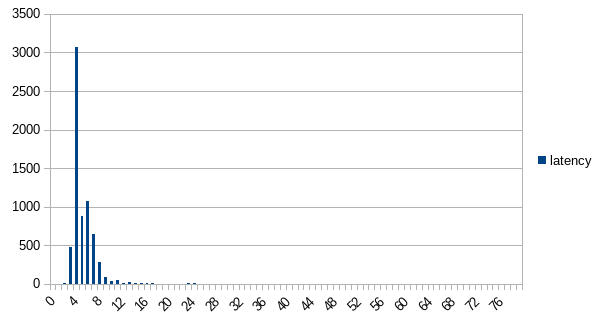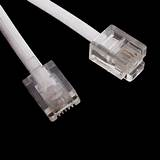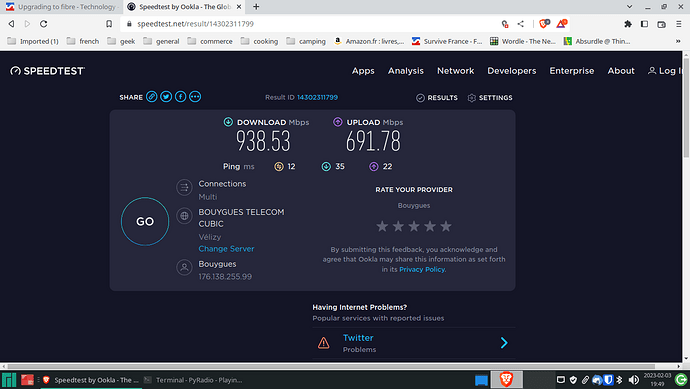@Fleur Were you already an Orange customer and did you get an installation charge?
@JohnBoy Yes the final leg from the buried cables is routed over the telegraph poles to the house. I wasn’t sure if it was fibre all the way but from what people are saying and because the speeds are so high, it definitely looks that way.
I can’t see your screen shot?
Yes. But we were existing Orange customers. And as the technician put his foot through a couple of our roof tiles he installed the whole thing, including checking our livebox was live. ![]()
I have been an Orange customer for several years, in fact since ADSL suddenly became available. I believe the fibre installation was free. At least, I don’t remember paying.
That’s very good in terms of speed, but 12ms latency is a bit disappointing - I was hoping it would be low single figures.
I consider 12ms very fast, I video conference to New Zealand daily without any problems whatsoever, and I download large files(+1gb) in seconds, I dont do any gaming but would imagine that kind of ping very good.
Our figures are very much like yours.
I read up on the latency/ping this morning… Apparently, in fiber-optic cable, each kilometer causes a latency of 4.9 microseconds.
Typical latency …
Fibre : 10 to 12 ms.
DSL : 11 to 40 ms.
Cable : 13 to 27 ms.
Satellite : 594 to 612 ms.
Our old satellite internet was painfully slow to put anything on the screen! Fibre is greased lightning in comparison.
I spent a year using 4g with 3Mbs down so I now appreciate what I have, in the UK I had 100Mbs and I thought at the time that it was fast.
12ms is OK, but some perfectionist online gamers (I’m no gamer!) might not agree; in the UK using Virgin broadband, it was 9ms and some people we know using various services can get to 5ms. But latency can mean a lot of things - it depends on where the server is that you are connecting to, for example. Video conferencing isn’t a latency-sensitive operation (unless the connection is really bad). We use Zoom a lot here and even with latency measured at 40 or 50ms it’s not noticeable.
Without more context it’s hard to tell, latency will vary with the end points and it’s not something that is really possible to represent with a single number.
Speed of light in fibre is (ish, depends on the refractive index) 200000000m/s so, yes, 1000/200000000 = 0.000005 seconds or 5μs so the 15,000km between the UK and Australia means about 75ms each way or 150ms round trip.
So why do packets between me and www.canberra.edu.au take almost twice as long at ~ 280ms?
The answer is that delays across network switches and routers adds considerably to the latency of an end to end connection between two hosts, this latency varies as well - typically the switches and routers that ISPs use move packets blisteringly fast purely in hardware - but if the route across a swtich isn’t in the hardware tables it might have to be looked up in software which typically takes a lot longer.
Therefore the more switches and routers your packets have to cross the longer and more variable the latency becomes, and once the packets leave your ISPs network you are totally dependent on other organisations for the performance of your connection, it might depend on “peering agreements” between ISPs and the core network providers, or content delivery networks. For instance I’ve seen packets between two UK located computers be routed via Hong Kong because of lack of an agreement between two ISPs and some questionable route advertisements.
Latency also varies as routers - especially the ones in your home - queue packets waiting for their turn on a physical link (not so much big ISP switches and routers, they tend to drop packets rather than queue them if there too much traffic)
So, what does Ookla give you - well, they have agreements to run servers with various ISPs - in your case it looks like Bouygues host a server so it should be close to you and give a good indication of the lowest ping you will see (ideally you’d measure this at the “first hop” point), you have an idle ping of 12ms, ping latency increases to 35ms during the download test and 22ms during the upload test.
Those are pretty good - I get 14ms, 74ms and 15ms on my 500Mbps TalkTalk connection (as reported by Ookla) so you’re pretty much getting the same, but much better on latency during download (the fact that yours is 2x better than mine is almost certainly not related to the fact that your connection is 1Gbps and mine is only 500Mbps).
The “real” latency of my connection - as measured at the first hop router, with stats from about 6800 packets - 4ms, but with a range from below 2ms to nearly 80ms

I honestly would not be worried that 12ms is high latency for a fibre connection.
Thanks for this great explanation Billy !
That’ll be the GCHQ intercept, @billybutcher - they’re on to you… ![]()
Looks like we will be moving our two cheap Bouygues mobile sim cards to Orange as well as connect to their fibre service, costing €39.99 per month for the first 12 months. This includes new customer discounts though apparently Bouygues 4G box we currently have doesn’t qualify for an extra €4/month discount if we had already had landlline broadband. There is no installation charge either. We declined the Orange TV package as we don’t need that (we have a Smart TV plus Amazon Fire TV already) and it has a €40 activation charge.
You’re really not missing anything… It’s awful.
In the countryside it seems that many departments or regions are responsible for installing the fibre infrastructure, to the cabinet. The big providers like Orange, SFR etc are then responsible for connecting the subscribers premises and pay the departmental/regional entity for access to the network. So, many people may have had Orange install thier line, but in many places they have not created the infrastructure. Here is a list of the RIPs that have been created to install the infrastructure in France. They don’t cover all of the country, but quite a lot of it. The Dordogne seems to be not covered by a RIP.
Les réseaux d'initiative publique déploient la fibre optique en zone non dense
One interesting point is that Orange are the people who build the infrastructure for some RIPs, but they don’t actually own it, they have just been subcontracted to do the work and the RIP owns the infrastructure.
I live in an isolated Mas about 1.5Km from the village. Fibre suddenly became available when workmen strung the line along the roadway (using the existing telephone poles)
Orange even phoned me up to ask (bit pushy) if I wanted to upgrade to fibre and I said “yes”
Technicians came, looked for the distribution box, and said that they couldn’t do anything as they only had ladders and access to the poles needed a cherry picker, so they went away.
Some time later more technicians arrived - in a van with ladders! So they went away.
Third time’s a charm, they say, and the next guys arrived (with just ladders ) but this time said that the box was 500 metres away, and between the house and box there were loads of trees (c’mon - we live inside the Cevennes National Parc; what were they expecting?). They would be back to string the line once we had paid to cut down all the trees between us and the box. Yes it is our land, but No it’s bloody expensive.
There is of course a second box, 600 metres the other way, but that is too far seemingly.
So we cancelled the upgrade.
Really annoying thing is that one of the supports for the lines is between two real poles, and is our house!
So - it’s actually €36.99 per month fort the first year after the discounts, for 500 megabit fibre, a Livebox 5, and moving our two very basic sim cards from Bouygues, though we had to pay €10 each for the replacement sim cards. There is no installation charge. Assuming this all works properly, I will be very happy. I also didn’t realise that you get a landline phone port with the Livebox and a phone number - shame I got rid of all our old landline phones! I do have an old one for posterity but I guess it will need an adapter. I’m expecting the installation will take place in 3-4 weeks.
If the phone has an RJ11 type connector (as opposed to the old French T style it should work. You can also buy the preformed RJ11 cable from most supermarkets that sell this type of thing.


